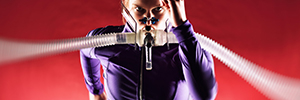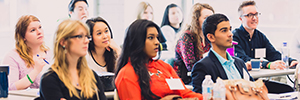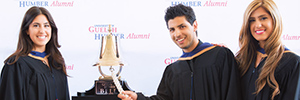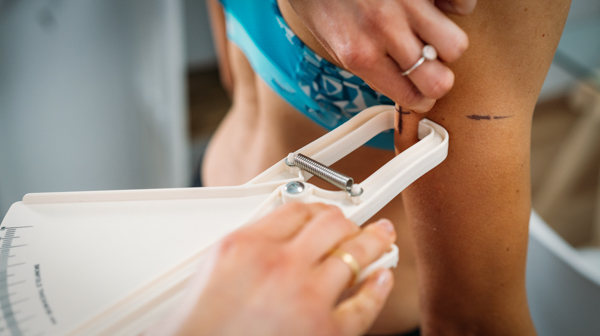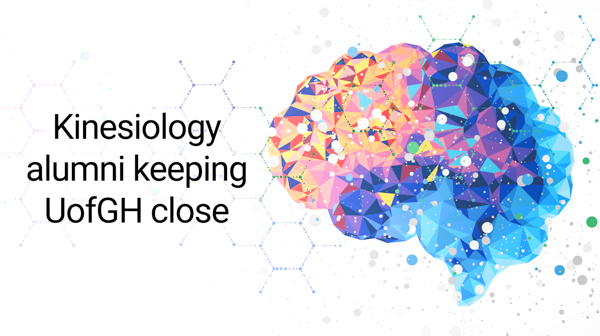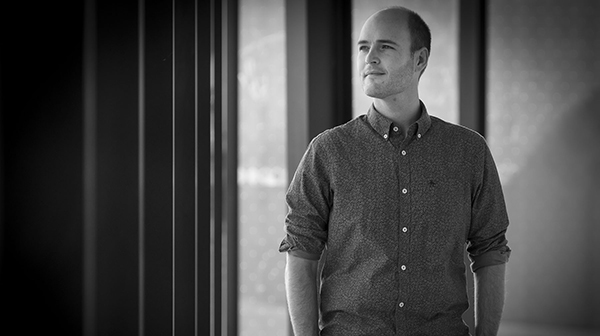- Future Students
- Current Students
- Faculty
- Staff
- Alumni
- Others
Skeleton models help Kinesiology students explore human anatomy
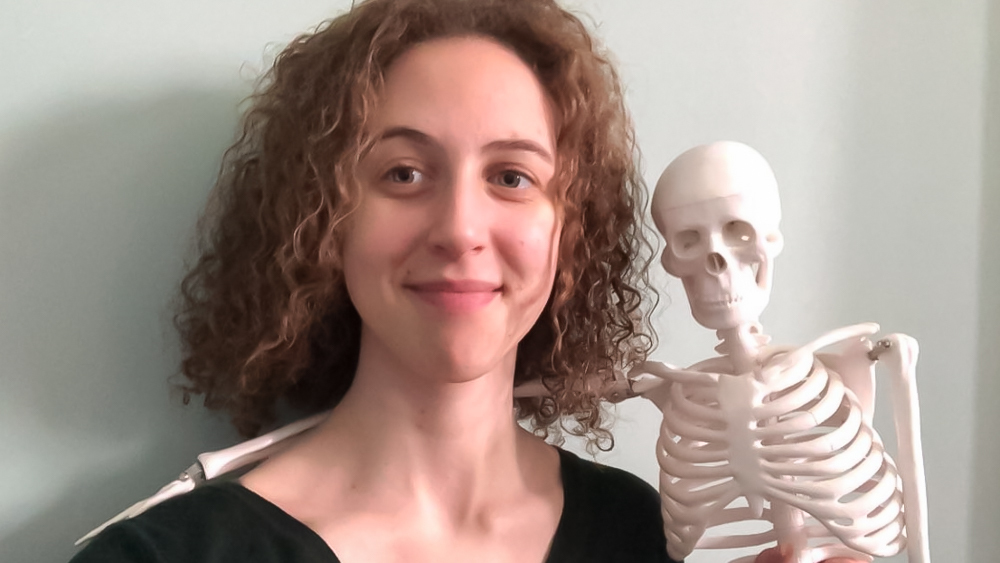
Photo courtesy of Rileigh Stapleton
When first-year Kinesiology students began their “Human Anatomy” courses this school year, they each received a unique study tool: a 35-inch-tall miniature human skeleton model.
The skeleton—which includes anatomical details and moveable body parts—is one of the many creative ways the University of Guelph-Humber Kinesiology program is providing a hands-on learning experience while teaching virtually.
Jaffar Hashimy, a first-year Kinesiology student, recalled receiving his skeleton back in the fall. “I didn't expect it to be so detailed and so fascinating,” said Hashimy. “There's so much to learn with the human body. Sometimes it's hard to visualize. With the help of the skeletons, it makes it a lot easier.”
First-year Kinesiology student Rileigh Stapleton has appreciated having the skeleton throughout the year. “I named him Lil Mac. He’s awesome,” said Stapleton. “It’s really helpful to be able to actually look at something instead of just a picture on a screen.”
In addition to being a useful study aid, students have been using the skeletons in a variety of ways. In the fall, they completed an assignment using the skeleton model and other materials, such as clay or paper mache, to present a three-dimensional view of muscle groups. This semester, they have been attaching string to the skeleton and pulling on the origin and insertion of particular muscles to see how the action would appear in the body.
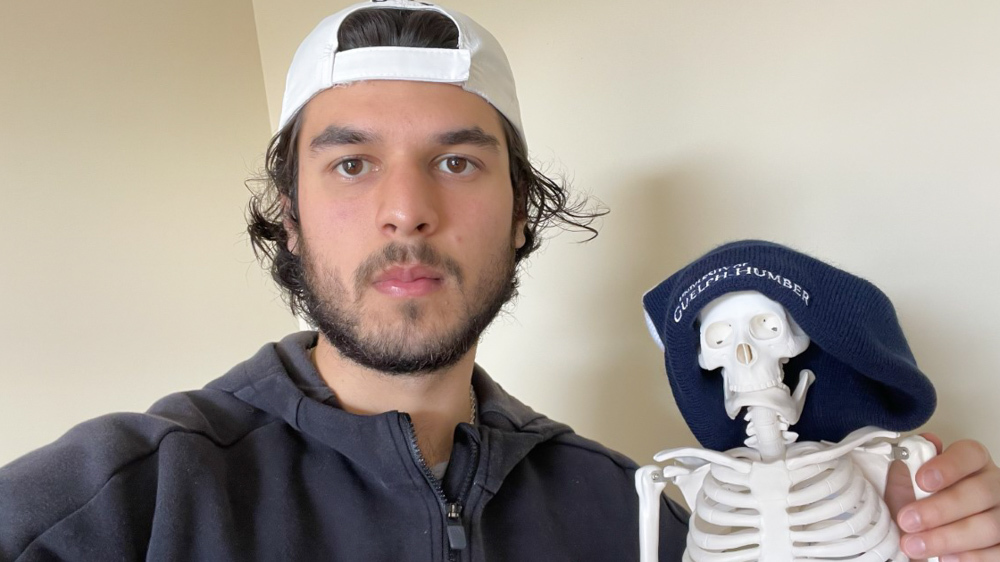
Photo courtesy of Jaffar Hashimy
Human anatomy and osteology—the study of the structure and function of the skeleton—are two essential areas that Kinesiology students take a deep dive into during their first year.
“Foundational to the study of the body is the skeleton,” explained Dr. Lorraine Jadeski, who taught the fall semester of “Human Anatomy.” “Osteology is the landscape upon which we attach muscles and then follow blood vessels and nerves, so it's really fundamental to the students’ vision of structures and relationships.”
“The skeleton adds a certain dimension of hands-on learning to give them that foundational vision of where the structures are relative to each other,” added Dr. Jadeski. “It's so important that they have access to a three-dimensional model of something that they can look at to try and internalize the structures and their relationships.”
A virtual cadaver lab
Kinesiology students typically visit a human cadaver lab as part of their anatomy courses starting in their first year, first semester at UofGH. This year, the lab has adjusted to a new virtual format.
Each week, the anatomy lab team gives a live demonstration on a cadaver, shown through various camera angles. Afterwards, students work in small groups to identify and discuss the different body structures.
While the students are unable to visit the lab in person, they still appreciate the up-close look at the cadaver.
“That was one of the main reasons why I chose Guelph-Humber, because we have the first-year anatomy cadaver lab,” said Hashimy. “But they made up for that with the online labs. It's not the same, but it's very helpful. They do their best to give us that experience that we can't get because we're at home.”
“We still get to see everything,” added Stapleton. “It would be great if we could be there but getting to see someone else interact with it and show us how all the pieces fit together is almost just as good.”
New learning environments
Dr. Andrea Clark, who is teaching the winter semester of “Human Anatomy,” has been finding new ways to engage her students—and has found success in some unexpected settings. One of her students’ favourite activities is following along with exercises and stretches, which Dr. Clark leads from her basement.
“Together as a class, we've been doing stretches. As we've been stretching different regions of the body, then we can recall out loud what muscles are in there and what their origins and insertions are, and maybe twist slightly one way or the other to get a better stretch for those particular muscles that we're interested in,” said Dr. Clark. “They love the basement. I don't think I've ever had so many requests to repeat something.”
One of the benefits of online teaching, Dr. Clark said, has been the opportunity to do hands-on activities, such as stretches, without being restricted by space.
“That's something that I can't do much in the classroom,” Dr. Clark said. “You can't have them sit on the floor, because there's just not enough room, whereas they're all in their bedrooms or homes now.”
“It's certainly very different, but it's actually been quite a lot of fun,” Dr. Clark said, reflecting on the experience of teaching virtually. “We have been able to build a community within the class without actually ever meeting face-to-face, which I think is quite remarkable. I'm very proud of that.”
Though students may not have had a typical first year, the anatomy team has been working hard to give Kinesiology students an engaging learning experience.
“On behalf of the whole Kinesiology program and our students, I would like to express a huge thank you to the whole anatomy team, to the instructors, the teaching assistants and the lab technicians who run the cadaver labs,” said Dr. Agnes Coutinho, Acting Program Head of Kinesiology.
“They not only did an amazing job pivoting and successfully adapting to remote delivery at the start of the pandemic, but they have continued to find innovative ways to keep enhancing the learning experiences of our students.”
The team’s hard work has certainly been noticed by the students. They appreciate all the effort the anatomy team and Kinesiology program have put into creating a memorable first-year experience.
“Dr. Clark and Dr. Jadeski have been so understanding and easy to talk to,” said Stapleton. “When we're in our lab sessions, we have breakout rooms, and they will pop in and just say hello. I think definitely having them be such great characters and teaching online throughout this entire thing is just incredible.”
“Anatomy has been a great class,” added Hashimy. “I have to give credit to the whole anatomy team, because it's a difficult time for everyone. How everyone has adapted is very awesome.”


